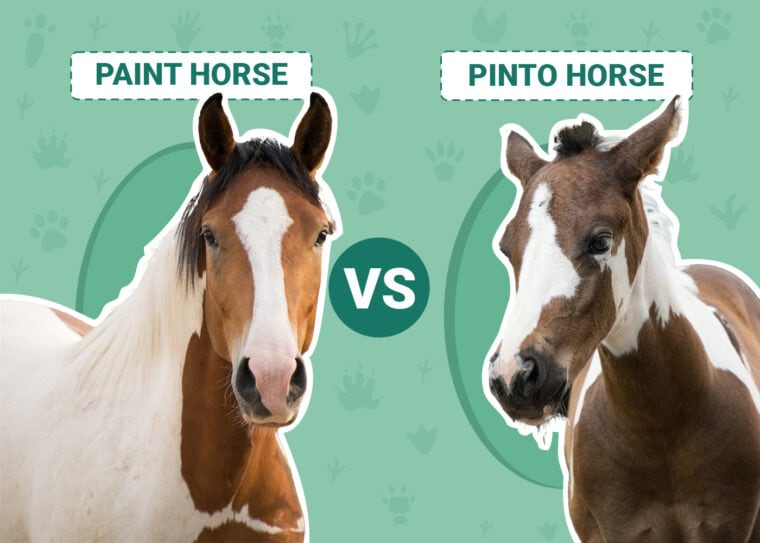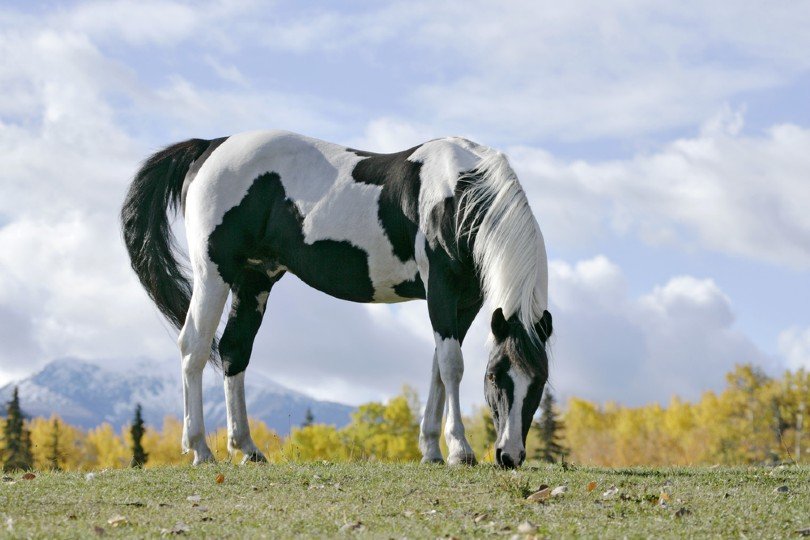
You’d be forgiven for confusing a Pinto horse with a Paint horse; the two are similar in appearance, with both having a distinctive, patched, multi-colored coat. To add to the confusion, the terms “paint” and “pinto” are often used interchangeably when describing horses with these coats. That said, the biggest distinction between these two horses is that a Paint horse is an actual breed of horse, whereas Pinto is a term used to describe horses with multiple patches of color in their coat; Pintos can actually be any breed of horse.
In this article, we attempt to demystify the differences between a Paint horse and a Pinto horse and take a look at what makes them unique. Let’s get started!
Visual Differences

At a Glance
Pinto Horse Overview
Pintos are typically bred for their coloring, so no set standards or conformation define what a Pinto is. Any horse breed displaying certain colors and patterns can be defined as a Pinto, and this terminology also varies by country. These horses often have distinct pattern types that are referred to as piebald or skewbald, depending on whom you ask.

Personality / Character
Since a Pinto horse can be any breed, its personality and character can vary widely. That being said, certain horse breeds produce Pinto coats far more often than others, including the American Saddlebred, and some breeds, such as the Spotted Saddle Horse and Spotted Draft Horse, are exclusively Pinto in coloration.
When it comes to Pintos, it can be difficult to pinpoint the exact personality and character, as this mostly depends on the breed of the horse. In general, however, breeds displaying Pinto coloring are intelligent, trainable, and easygoing and are typically powerful, muscular animals too.
Appearance
A Pinto horse’s coloring is often described as either “Tobiano” or “Overo.” Although there are other pattern types, these are the most common and the most desirable among breeders. Typically, a Tobiano Pinto has a white body with large areas of color that often overlap, with a greater percentage of white than color. Overos, on the other hand, are colored horses with white markings that spread outward from the horse’s belly toward their neck, tail, and legs. The color tends to frame the white spots, and Overo horses often have dark tails, manes, legs, and backs. There also exists a combination of these two types, referred to as a “Tovero.”
Health & Grooming
Like all horses, a Pinto horse will need regular brushing and grooming to keep their coat healthy and shiny and free from skin conditions. General care of a Pinto includes regular mane, tail, and hoof maintenance.
Pintos may suffer from several genetic disorders due to the genetic mutation that causes their coloring, including lethal white overo syndrome, hereditary equine regional dermal asthenia, and lavender foal disease, although these are generally healthy, long-lived animals.
Suitability
The Pinto Horse is an ideal animal for anyone looking for a recreational horse for trail riding, pleasure riding, or even general equestrian sports. They are generally calm, friendly, and good-natured animals that are intelligent and easy to train, making them ideal for beginners and novice horse owners. Also, their beautiful coat makes for a truly unique, eye-catching animal!
Paint Horse Overview
Paint Horses are a popular breed, partly due to their unique coloring, as well as their gentle demeanor, adaptability to a wide range of uses in the equestrian sport world, and use as a general working horse. Paint horses have stringent bloodline requirements according to the American Paint Horse Association (APHA) and can only have Thoroughbreds, Quarter Horses, or other Paint Horses in their pedigrees.

Personality / Character
Paint horses are prized not only for their beautiful markings but also for their calm, easy-going, gentle, and social natures. They are also highly intelligent horses that are a breeze to train, and as such, they are ideal for novice horse owners. These horses are known to be reliable and hard-working, making them ideal candidates for a wide range of horse sports.
Appearance
Paint Horses are both taller and heavier than many other horse breeds, especially those with a Thoroughbred heritage. Their unique coats come in a wide range of combinations of white with other colors, most commonly black, bay, or chestnut. No two Paint Horses are exactly the same. Like the Pinto, Paint horses mostly come in three distinct marking variations: Tobiano, Overo, and Tovero.
Health & Grooming
The general maintenance and grooming of a Paint Horse are no different from that of standard equestrian grooming practices, and weekly brushing and combing with regular inspections are needed to maintain their beautiful coat.
Paint Horses are generally healthy, long-lived horses, but they are prone to a few genetic health issues, some of which also run in Thoroughbred and Quarterhorse lines. These include lethal white syndrome, hyperkalemic periodic paralysis, and more rarely, hereditary equine regional dermal asthenia.
Suitability
The Paint Horse is a versatile, gentle, and social breed that is ideal for both beginner and experienced equestrians alike. They are intelligent animals that are easy to train and can be used for a variety of equestrian sports or just for pleasure riding. They are also generally healthy animals that are easy to look after and are ideal for just about any horse-loving home.

What Are the Differences?
While a Pinto and a Paint Horse may seem similar at first glance, they can vary widely in personality, size, and temperament. This is mainly because a Pinto is not a breed of horse, but rather a term used to describe a certain coat pattern, so they can be of almost any horse breed. This makes it exceedingly difficult to predict the character of a Pinto, knowing the parent breeds will help tremendously.
Paint Horses, on the other hand, are a separate breed altogether, making their temperament and character far easier to predict. They are generally gentle, easy-going, and calm animals that can be put to a wide variety of uses.
In conclusion, Pinto Horses and Paint Horses can differ in almost every way, depending on the breed of Pinto, but their unique, beautiful, and striking coats are always something to marvel at!
Featured Image Credit: Top – khamkhor, Pixabay | Bottom – Brixiv , Pexels








